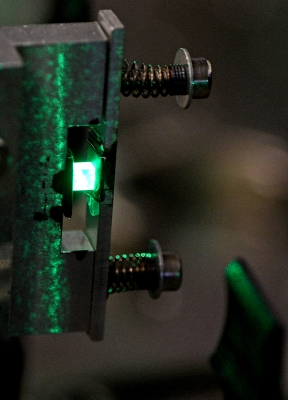Jan 20 2016
Those who want to explore the microcosm need exact control over laser light. Only with its help is it possible to explore electron motion and to influence their behavior.
 Through a lithium niobate crystal the laser physicists generate a few femtoseconds only infrared pulse. The waveform of the infrared light can be analyzed thoroughly by the researchers. Picture: Thorsten Naeser
Through a lithium niobate crystal the laser physicists generate a few femtoseconds only infrared pulse. The waveform of the infrared light can be analyzed thoroughly by the researchers. Picture: Thorsten Naeser
Now, scientists at the Laboratory for Attosecond Physics at the Max Planck Institute of Quantum Optics (MPQ) and the Ludwig-Maximilians-Universität Munich (LMU) have developed a measuring system that is able to determine laser pulses with a wide bandwidth in the infrared spectrum of light precisely. In the infrared wavelength range as short as 1200 nanometers this was only possible with the help of complex vacuum systems until now. The new system can be used for the precise generation of attosecond-duration light bursts for the exploration of atomic systems, as well as for the controlled dynamics of electrons in crystals.
Light is an elusive medium. Reaching close to 300.000 kilometers per second, light is not just incredibly fast, its electromagnetic field is quite a flutter: it oscillates roughly one million billion times per second. In recent years, however, researchers succeed in watching these oscillations more precisely and even controlling them. With this, light is an ultra fast tool for exploring the microcosm.
Infrared light pulses a few femtoseconds in duration serve in this context as a reliable light source for the generation of attosecond-light-pulses. With the help of attosecond-long light bursts, one is able to “photograph” electrons. On the other hand, one is also able to stimulate electronic motion in molecules and crystals with the help of infrared laser pulses and thereby change their electronic properties within femtoseconds. One femtosecond is one millionth of one billionth of a second; an attosecond is a thousand times shorter.
The better you know the form of the infrared laser-pulses, the more precise the experiments that can give us information about the phenomena inside crystals can be performed. Now laser physicists of the Laboratory for Attosecond Physics around Dr. Nicholas Karpowicz and Sabine Keiber at the Max-Planck Institute of Quantum Optics and the Ludwig-Maximillians University Munich have developed a measuring system, based on the electro-optic sampling technique developed for the far and middle infrared, that allows analyzing the exact waveform of light waves in the infrared range down to 1200 nanometers wavelength. Within this measuring system, another five-femtosecond laser pulse scans the electromagnetic field of the infrared pulse. “A laser pulse consists of a coherent oscillation of the electromagnetic field” Nicholas Karpowicz says. “With this technology we are now not only able to define the envelope enclosing these oscillations, but also to directly analyze the shape of each of them.” In this wavelength range down to 1200 nanometers such a precise analysis was only possible in the context of an elaborate experimental system until now.
With this newly-acquired control over the near infrared pulses, the possibilities for exploring the microcosm broaden. This analysis method may also support further technological development in the field of data transmission with light. Since information transfer often uses a light wavelength of roughly 1550 nanometers, the precise measuring system presents opportunities to better understand light-matter interaction in the important telecom band. The system can also be used in basic research. The technique is able to improve the time-resolved infrared-spectroscopy for the examination of biological and chemical samples.